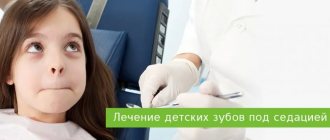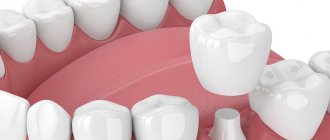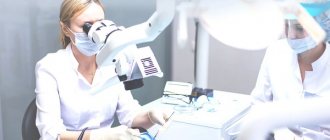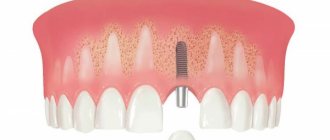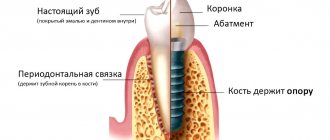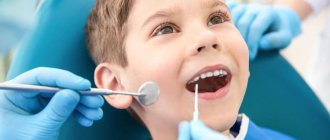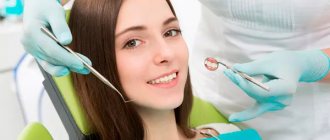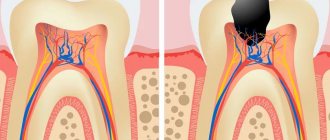Caries: features, symptoms
According to statistics, at least 95% of people in the world have encountered caries at least once. This is the most common dental disease that affects people regardless of gender, age and lifestyle.
Caries belongs to the list of pathological processes. Initially, it begins to destroy the enamel, but if left untreated, it also affects the deep hard layers of tooth tissue. When soft tissue inflammation begins, blood vessels and nerves are inevitably also affected.
Patients often wonder whether tooth decay needs to be treated. In fact, it is necessary not only to engage in prevention, but also to begin treatment as soon as possible. If the disease is neglected, there is a high risk of losing the tooth completely.
“I treated my teeth during a pandemic”: dental detective
For two months now, dental clinics have been operating according to new standards - patients are accepted only with acute toothache. That is, it will not be possible to restore a chipped tooth or put a filling. We must wait for pulpitis - inflammation of the internal tissues of the tooth.
All people are different. Some are ready to numb the pain with medications and endure until the last moment. Not my option. I didn’t wait for irreversible consequences.
A week ago my filling fell out. I immediately went to a private dental clinic.
– I have a hole in my tooth. A tooth chipped a little, she described the problem.
– Is there any acute pain? – the first thing they asked at the reception.
- No.
“Then wait for it to start.” We take it exclusively for acute pain.
“But I feel that acute pain is about to begin.” There is still some discomfort.
– When pressed or what? Please explain in more detail.
The ridiculous conversation lasted fifteen minutes.
- Let's pre-register you in three days. Will you endure the pain? It will still not be possible to accept you earlier. An hour before the visit, the doctor will contact you, explain the situation in detail, and he will decide to accept you or not.
The doctor called at the appointed time. I once again described the symptoms - a filling, a hole, a chip. And she added: “It seems like the tooth will fall out soon.” I didn’t write about the acute pain. But she warned: “If acute pain hits, I will die.”
The doctor sighed loudly: “Well, I don’t even know what to do with you.” I reassured him: “Don’t worry, I’m absolutely healthy - I don’t have coronavirus.”
“Okay, come, let’s see,” the dentist took pity.
I turned out to be the only visitor to the clinic. At the reception desk, the administrator met me fully armed - wearing a mask, gloves, and a bottle of sanitizer on the table. The lady kept a decent distance from me.
“During the epidemic, many will lose their teeth,” said the clinic employee. – People come to us now when they can no longer stand the pain, the tooth is practically destroyed. We've had a fair amount of teeth pulled out lately.
I was asked to fill out a form. I enter my passport details, registration, actual place of residence, and leave contact information. Below are a few more points, opposite which you should put yes/no: have you left the region in the last 14 days, have you had COVID-19, are there any cold symptoms (indicate which ones), have been in contact with infected people.
– You don’t require certificates from patients? – I ask at the reception desk.
– People came to us who honestly admitted that they had been ill with coronavirus. They showed a certificate that they were healthy. We take the rest at their word. What can we do? We hope for the decency of citizens.
We cannot check whether a person has COVID-19 or not, whether he has traveled somewhere out of the region or been in self-isolation at home. We have a private clinic, we can still filter patients, but my friend works in a government institution. There are a lot of people there. Which one of them is a potential carrier of infection, which one is healthy - go figure it out.
I go to the doctor's office. I notice fear in the dentist’s eyes. I feel uneasy too. I sit down in a chair. The inspection takes place without further ado.
“The caries is deep, it’s a long, serious job, let me make an appointment with a more experienced dentist the next day,” it seems that the doctor was happy about this state of affairs.
I didn't argue.
Three days later another visit to the clinic.
Much more people gathered in the clinic to see the experienced doctor. In the corridor I ran into a 65 plus lady. A woman in a mask and gloves leaned on a stick and grumbled under her breath: “You’ll lose your last teeth while you wait for the end of the strict regime.”
A girl was fussing nearby. I hung my outerwear in the closet. “Hang your jacket away from mine, otherwise there might be a virus on your things, then it will jump from your jacket to my coat,” I suddenly heard addressed to me.
The atmosphere in the dental clinic is nervous - every patient is suspicious. Everyone avoids each other. Nobody communicates with anyone.
I go to the doctor's office. I sit down in a chair. While the freeze was in effect, I talked with the doctor and assistant. All conversations come down to one topic.
– I recently took an antibody test, and it turned out that I had been ill. When? “I have no idea,” the assistant says calmly.
– So you can get infected from patients too? – I undertake to reason.
“Dentists are always at risk,” the doctor joins the conversation. – In addition to Covid, people come to us with hepatitis, tuberculosis, and other diseases. So, should we all refuse?
– Nowadays people mostly come to you with acute pain?
– We understand that people are often cunning. Especially in government hospitals. There's a ton of patients there. Now people are sitting at home, there is nothing to do, and everyone has unanimously decided to cure their teeth while there is time. They say there are huge queues there.
Dentists understand that the person came clearly without any particular need. But if the patient declares that he is in pain, they cannot refuse treatment. We have the same situation. We are constantly being checked. I don't want to run into fines. Of course, we won’t install veneers or clean your teeth now. This is a direct violation.
The doctor put on a mask, gloves, and a protective shield and got to work.
We didn't talk anymore.
Before leaving, I asked the doctor for one more thing. The dentist smiled: “Let's not take risks. We’ll meet after quarantine, unless, of course, you’re in acute pain.”
“Wait out the night, if your tooth hurts, then we’ll take it.”
We contacted other dentists who shared the challenges they are facing during the pandemic.
Marina is a doctor from Kaliningrad, works in a private clinic.
“Since the beginning of April, we have been accepting patients strictly for acute pain,” the interlocutor began. “In a month and a half, our patients have not yet lost all their teeth. But we are already facing problems. There are many requests from patients whose caries has turned into pulpitis. Some people endure until the end, when it’s too late to save the tooth.
There are those who come in a “borderline state”: either caries, or they have reached pulpitis. If it weren’t for quarantine, I would definitely tell them: “We open it up, see what’s there and treat it according to the circumstances.” In the current situation this cannot be done. Because if we start treating ordinary caries, and they find out about it, they will fine me, the head physician, and the clinic.
Therefore, we send such “incomprehensible” patients home with a recommendation: wait out the night - if your tooth hurts, then come. Roughly speaking, we are forced to wait for irreversible consequences to begin.
According to the interlocutor, they are forced to refuse a patient with ordinary caries. Most are understanding.
“If inspections begin, and in our journal they notice the inscription “treatment of simple caries,” we will be fined,” explains Marina.
– So you write something else in the magazine?
– Each diagnosis has its own clinic. And the price. Treat caries, but write acute pulpitis? This is falsification of documents. Criminal liability. Plus, are you willing to pay the price difference? Treatment of caries costs 4 thousand rubles, and pulpitis – 9 thousand. If I write pulpitis, but take it as caries, then I will have to pay extra for you at the cashier. The list of prohibited manipulations now includes orthodontics (treatment of defects in the development of teeth) and prosthetics.
“Patients are not fools; they can always come up with a feeling of, if not acute, then aching pain.
– If a person complains of aching pain, we will not accept him. The pain must be really sharp. If a patient comes with swelling on half the face, then we can treat it,” continues Marina. – If a person’s filling just fell out, the tooth reacts to cold or hot, he cannot eat on this side – we won’t accept it either. You can chew on the other side as well.
– What are the fines for violations?
– I can’t say for sure, we weren’t fined. I heard out of the blue that the director of the clinic must pay about 500 thousand rubles for a violation, and the same amount is charged to the head physician. An ordinary doctor will be charged 3 thousand rubles.
– Are there new rules for disinfection in your clinic?
– Hand disinfection, entrance to the clinic only in masks, the distance between patients in the corridor is one and a half meters.
– When will you start working as usual?
– Information has reached us that we will be the last to open. Approximately July 1st.
“Russians are used to enduring pain”
Svetlana works at the Sterlitamak state clinic in Bashkiria. Here's what she says.
“Everything is strict with us - we only accept patients for acute pain. But if a patient comes with a complicated diagnosis - pulpitis, periodontitis, then we do not abandon the patient halfway, we continue to treat the tooth that caused the pain before filling. Naturally, we are not currently carrying out complete rehabilitation (a set of measures aimed at treating diseases). We explain to people that teeth that don’t hurt can wait for treatment,” says the woman.
– Do you often encounter situations when there is nothing left to save?
– Now many people are afraid to come, even with acute pain. If a person endures to the last, then in some cases the tooth can no longer be treated. This happens not only during a pandemic, but also in peacetime. Russians are used to enduring pain, but now there are many more such people who are patient. Previously, we always urged not to delay treatment. I even have a poster hanging in my office: “Don’t be afraid to go to the dentist often, otherwise it may be too late.” These recommendations are now inappropriate.
– Surely there are patients who are just against waiting for acute pain?
- Certainly. We are being deceived now too. People came to me and complained at the reception desk about severe pain. During the appointment, it turned out that the patient’s filling had simply fallen out. We accept such people. If I refuse, he will complain. And no one can prove whether the person really suffered acute pain or not. Theoretically, only two people can know that a patient is in unbearable pain - he and the doctor. I, as a doctor, describe all the symptoms and complaints in the card.
– Was your clinic fined?
– No fines have been issued yet. It’s hard to find fault in public clinics. Our problem is that almost all patients scream that they are in pain. And they sit down in a chair and it turns out that there is no pain.
– Dentists are at risk. Are you scared to work in the current conditions? You can get infected from any patient.
- Of course, it’s scary. We are in close contact with the patient, but we do not know whether he has been diagnosed with COVID-19. The clinic is currently undergoing additional treatment and disinfection of all rooms; we frequently ventilate and quartz the rooms. All patients and doctors upon entering the dentistry have their temperature taken, their address and all their data are recorded. You have to trust people, although many themselves do not know whether they are sick or not. So far, none of my colleagues I know have become infected.
“You can live without teeth – no one will see you wearing a mask”
There is a heated discussion on dentist forums about how to work during an epidemic.
This is what doctors write about their responsibility.
“Private clinics operate at the discretion of management. You can agree and not take shifts for those who are afraid. The state ones are plowing in full. There are tons of people – both old and young come.”
“If a patient who was treated by you subsequently falls ill, then the blame falls on the clinic. Checks will begin. The dentist will not prove that he is not at fault. If the chain of infections from your patient grows and, God forbid, someone dies, the doctor faces a criminal sentence, like up to 7 years in prison. The clinic will be fined up to 2 million rubles, and the institution itself will be closed.”
“Any patient is regarded as a potential carrier of coronavirus. There is no need to explain to anyone that the probability of our infection when working with such a patient is 100 percent.”
“When treating an infected patient, the chance of catching the virus from him is high. An ordinary dental mask does not protect. You need a respirator, goggles that fit tightly to the skin, such as swimming goggles, plus a screen. Before the procedure, the patient must rinse his mouth with a disinfectant solution for at least five minutes before any procedure.
Quartzing the room is necessary after each patient.”
Doctors also talk about how treatment is carried out today.
“If simple caries is not treated for a long time, the situation can lead to pulpitis. If help is not provided in time, the situation will lead to serious consequences for the tooth and the body. Now we are prohibited from putting permanent fillings, only temporary ones. Unfilled canals can lead to tooth decay. According to current rules, no more than 30 minutes are allocated for each patient, and 15-20 minutes for children. What can you do in this time?”
“The head of the clinic explained to us: if the diagnosis is caries, write that the cavity is large, the person cannot breathe, the air causes sharp pain. If a filling falls out, we write down - the sharp edge of the tooth sticks out, the tongue and cheek are torn into blood. So at least we’ll save people.”
“Dentists are told to only place temporary fillings in case of acute pain. No additional work. No calcium. No permanent filling. And how can a person live with this?
“We had to remove the patient’s tooth in the center. She cried, complained, how could she appear in public like this before the end of quarantine? Our administrator reassured: “No one will see that you don’t have a tooth. You can't go anywhere. But wherever you can, you’ll still wear a mask.”
There are several categories of causes of caries in humans.
The answer to the question of how to treat dental caries depends on the cause of such a disease. It is also very important to eliminate potential conditions for the development of tooth decay.
There are several reasons that can stimulate the appearance of damage to enamel and soft tissues:
- Severe bacterial plaque. It occurs when a person does not properly care for his teeth. It is very important to maintain regular oral hygiene, brush your teeth properly, and use floss.
- Tartar. It can also form if the patient does not comply with the rules of oral hygiene. If the stone is not removed in a timely manner, the lesion will constantly progress and spread.
- Poor nutrition. Risk factors include consuming large amounts of sweet and sour foods. Also on the list of dangerous foods are foods high in carbohydrates and starch. When consuming a large amount of low-quality and unhealthy food, tooth enamel gradually begins to become thinner. Because of this, under the influence of bacteria, the risk of caries becomes increasingly noticeable.
- Decreased saliva production. Under normal conditions, a person produces up to two liters of saliva per day. It is necessary so that food debris can be washed off the surface of the tooth. When the salivary glands do not function properly, these residues remain and the risk of bacterial growth increases.
- Lack of minerals in food. The human body either does not produce many useful substances that are needed to strengthen bones and tooth enamel, or receives them in small quantities. The list of main substances that must be obtained from foods includes fluorine, calcium, and phosphorus. At the same time, genetics also leads to problems for some people. Some people are simply genetically predisposed to accumulate a minimum of nutrients.
- Pregnancy. At different stages, there is a possibility that the fetus takes a lot of useful substances from the mother. She begins to experience a severe lack of minerals.
- Diseases of the body. Patients with systemic pathologies that directly affect metabolic processes are also at risk. Particularly dangerous are variants of diseases such as lesions of the thyroid gland, peptic ulcers, diabetes mellitus, gastritis, and imbalance of hormones in the body.
Another factor in the development of caries is the poor environmental situation in a person’s place of residence. It can stimulate the development of caries, rapid damage to both hard and soft tissues.
For this reason, a high incidence of caries is observed in regions where there are a lot of acids, heavy metal salts, and alkali vapors scattered in the air.
In order to develop a treatment method in a certain situation, it is necessary to understand what reason for the development of the disease is relevant in the case of a particular patient.
The fact is that often it is chronic diseases, improper oral hygiene, and lack of nutrients that can trigger the recurrence of the disease. In any situation, it is very important to eliminate the cause itself.
Treatment of a tooth under a crown
After some time has passed after the installation of the prosthesis, subsidence of the gums and exposure of the neck of the tooth are often observed. All this contributes to the development of caries, and therefore pulpitis, periodontitis and other unpleasant diseases can appear even when the tooth is covered with a crown. Only a specialist can identify the problem and treat the tooth under the crown. If a disease is detected, the structure may need to be removed.
It is also the cause of problems - errors in the manufacture of the prosthesis: if the crown does not fit tightly around the neck of the tooth, bacteria can get under it. The specialist immediately removes such structures and carries out dental treatment. The crowns will subsequently be replaced, which will preserve the teeth and prevent the development of more serious diseases.
Main types of caries
How caries is treated in dentistry largely depends on which type of spread is typical for a particular person. There are several classification criteria:
- Spread intensity. This category includes single and systemic caries. The difference is that in the first case, the patient is not diagnosed with any additional symptoms. In the second case, the entire row or most of it is also affected. The constant spread of new lesions not only stimulates damage to the enamel and soft tissues, but also impairs the functioning of the human immune system.
- Complexity of development. Uncomplicated caries is the easiest to treat. In this case, there are no additional disorders that lead to the need for additional surgical intervention. Complicated caries is a situation that is accompanied by periodontitis and pulpitis. In this case, treatment must be much longer and more difficult.
In our clinic, doctors treat caries regardless of the stage of the process. We are ready to deal with a problem when there is one of the following four stages:
- Spot. In this case, only the enamel is affected. At the same time, there are spots on the surface with a dark or pale tint. Some people develop stripes instead of spots that are a different color from the rest of the surface.
- Initial surface position. The spot begins to gradually grow, and a hole develops. Sensitivity also increases.
- Middle stage of caries. Dentin begins to deteriorate and pain worsens.
- Deep defeat. Active necrotic damage to hard and soft tissues begins, nerve endings and blood vessels are affected. Treatment in this case will be much more complex and lengthy.
There is also another classification factor - the location and depth of tooth damage. There are five main classes:
- First. It is characterized by damage to the enamel. At the same time, at the first stage it will be very difficult to understand whether there is a lesion, because visually caries shows little of itself.
- Second. Most often it appears on chewing molars, as well as premolars, regardless of the jaw.
- Third. Found on canines and incisors. Most often, the problem is due to the fact that a person eats a lot of sweets.
- Fourth. Characterized by significant destruction of enamel.
- Fifth. The most severe type of flow option. In this case, caries can affect the entire row of teeth, manifesting itself closer to the gums, near the root - where it is very difficult to cure.
Anesthesia
Conventional local anesthesia is performed very often today. Patients with increased sensitivity of soft tissues and children can first be given topical anesthesia. Also in dentistry, painkillers are used for dental treatment. The type of drug and its dosage are selected individually - it all depends on both the patient’s health condition and the clinical situation. For example, pediatric dentists often treat teeth with nitrogen. Laughing gas causes a feeling of mild euphoria and is not hazardous to health. The patient relaxes, and the doctor can calmly perform all the necessary manipulations. But general anesthesia in dentistry is used only in the most extreme cases.
Anesthesia after dental treatment can last up to 3 – 4 hours. Everything here is very individual and depends on how much anesthetic was used.
Main signs of caries
Often, patients simply do not realize that they have tooth decay because they expect significant enamel damage, severe pain, or other common signs. But the best solution would be to contact our dentists in a timely manner for a thorough external examination.
There are several most common signs that a person is developing tooth decay:
- Change in enamel color. It can change color a lot. Stripes or dots of a dark or light shade appear. At this stage there may be no increased sensitivity or significant pain.
- Increased tooth sensitivity. It appears when eating hot and cold food, pressing, chewing, in the case of sweet or sour foods.
- Severe damage to the enamel. It is immediately noticeable by black holes in the teeth and partial destruction of the enamel.
- Pain. It can be of a different nature, either acute or long-lasting, aching. Depending on the type of problem, it either gets worse when pressing on the tooth or gets smaller.
- Bad breath. Occurs due to significant necrotic tissue damage.
Also, other manifestations are characteristic of the later stages of the disease - headaches, a feeling of shooting pain in the ears. For some, the inflammatory process stimulates fever, general weakness and decreased immunity.
Endodontic dental treatment
What is endodontic dental treatment? This is a procedure aimed at treating root canals, usually using a microscope. If you ignore the symptoms of caries for a long time, pulpitis, periodontitis and other complications develop. Endodontic treatment of teeth under a microscope will help eliminate acute pain and relieve inflammation. The help of an endodontist is indispensable when there is a suspicion of a dental cyst or granuloma. Often, after canal treatment, complications arise due to poor quality treatment or stuck pieces of broken instruments. In such difficult cases, they also resort to endodontic treatment of the tooth canal under a microscope.
Potential consequences and complications
The very question of whether caries should be treated is very dangerous. It is important to never doubt that treatment is necessary. Often a person observes the first symptoms of a problem, but begins to put off going to the dentist. The time for treatment is constantly being delayed more and more.
The main danger of this approach is the likelihood of complications. The most common among them is the appearance of periodontitis or pulpitis.
There are several of the most serious consequences of untreated caries:
- Tooth loss. If the tooth is severely damaged or the lesion has gone very deep, there is nothing left except surgical intervention.
- Pathological processes in the gums. They can lead to the need to remove not only the affected tooth, but also its completely healthy neighbors.
- Systemic complications in the functioning of internal organs. The gastrointestinal tract and immune system suffer greatly. It is important to understand that a sluggish inflammatory process has a sharp negative effect on the entire body and weakens it.
The question of how caries is treated in dentistry in children is always considered separately. It is necessary to solve the problem that has arisen with baby teeth, because advanced disease leads to pathologies in the formation of permanent dentition.
Features of treatment of anterior teeth
Treatment of anterior teeth is associated with some difficulties. A characteristic feature of the incisors is their smaller size compared to other teeth. The work that a dentist has to do is truly jewelry. Only an experienced specialist can achieve a high degree of aesthetics.
In the process of treating and restoring the shape of a diseased tooth, a filling can be performed using light-curing polymer materials or veneers. Their shade is selected taking into account the color of the enamel of the patient’s healthy teeth.
The last resort is the installation of crowns. This method is justified only if the tooth is severely damaged. Treatment of lower teeth in the frontal zone is performed using similar methods and techniques.
Methods for diagnosing caries
In order to develop a program for the correct treatment of a patient with caries, it is very important for the doctor to make a correct diagnosis and find out what caused the damage to the tooth tissue.
The work uses two main methods:
- Visual inspection. The doctor uses a special instrument to check the condition of the tooth and whether there are signs of damage. A detailed examination helps to understand which tooth is affected, even if there are no clear external signs.
- Radiography. X-rays in our clinic are performed using high-quality modern equipment. This allows you to get a clear picture of the condition of the deep parts of the tooth, its roots. In this way, it is possible to understand exactly how severe the lesion has developed.
Also, at the first appointment, the doctor collects a general picture of the person’s condition and finds out what the cause of the disease may be. A good dentist always tries to eliminate not only the tissue damage itself, but also the factors leading to its appearance.
Causes of dental problems
The occurrence of a problem such as caries is associated with the destructive effect of bacteria on the structure of the teeth. The microflora in the oral cavity includes a huge number of microorganisms. Even proper and thorough brushing of teeth with special means and the use of rinses cannot make the oral cavity completely sterile. The proliferation of pathogenic bacteria begins 2-4 hours after the last cleaning.
What exact reasons can cause tooth damage?
- poor oral care;
- unbalanced diet;
- decline in immunity;
- gastrointestinal diseases;
- avitaminosis;
- insufficient amount of minerals (calcium, fluorine) in drinking water.
How long does it take to treat caries?
The duration of the treatment procedure may vary depending on the condition of the patient and how deep the tissue damage has gone.
Depending on the initial conditions, treatment can be carried out in one or two stages. In the first case, the process rarely takes more than half an hour. In the second case, this time is extended over two visits - you need to kill the nerve and only then carry out other manipulations.
Thanks to their extensive experience and level of professionalism, our dentists cope with the task with minimal time.
Basic methods of caries treatment
A specific method of caries treatment is selected depending on the stage of the disease and how severely the tooth tissue is affected.
Let's consider the treatment method using the example of deep caries. It is quite common due to the fact that the patient delays visiting the dentist’s office for as long as possible. Among the central stages are the following:
- Examination of the affected tooth to determine the current condition. The doctor takes an x-ray, which will clearly show the extent of the lesion. This will allow you to create a plan for subsequent treatment.
- Anesthesia. Allows you to work with affected tissues painlessly. Today, high-quality, harmless drugs are used that can be used even in the treatment of children and pregnant women.
- Tooth isolation. It is important that the tooth is protected from saliva accumulating in the mouth.
- Removal of dentin affected by caries. This can be done using different methods, either using a standard drill or a laser. The dentist needs to properly form the cavity and also clean the space well.
- Treatment with antiseptics. This eliminates tissue damage, because there are a lot of blood vessels in the soft tissues of the tooth.
- Drying. If saliva does get into the cavity, the drying process allows it to be completely removed. Also, the air flow blows out any remaining tooth dust that remains after drilling.
- Placement of a temporary filling. Before this, a special calcium pad is also placed. The practice of installing a special temporary filling is necessary in order to reduce the risk of pulpitis.
- Choosing a specific filling color. This is especially important if you need to fill the visible part of the tooth that opens when you smile. Our dentists use many options of materials that can be harmoniously matched to the shade of the enamel.
- Filling. We use high-quality, durable fillings. They are created without the use of harmful substances and are not deposited in the body over time.
The whole process ends with the filling being ground and ground down. The dentist also determines whether it is comfortable for a person to close his jaws, and whether there is a feeling that something is in the way.
The doctor also comes up with a list of measures to ensure protection from most potential dangers and factors that could negatively affect the health of the tooth.
If the damage to hard tissue is small, only the superficial layer is affected, other means can be used:
- Infiltration. Involves a combination of chemical and mechanical means for treatment. This allows you to remove a small spot of caries. This approach is common if a person has been wearing braces for a long time.
- Ozone therapy. The technique allows you to achieve high-quality remineralization, as well as eliminate harmful bacteria that multiply in the body. In this case, drilling is excluded, and anesthesia is not required.
- Processing by air-abrasive method. In this case, a special mixture of air and abrasive material directly affects the carious cavity. At the same time, providing additional protection helps prevent particles from getting on the mucous membranes.
- Laser treatment. Modern lasers do not allow tissue to warm up. Using this technique, even children and pregnant women can be treated.
Our dentists carefully check the patient's current condition in order to understand which remedy will be most effective and safe.
Treatment without drilling
Dental treatment without drilling involves the use of minimally invasive procedures. Some of them have been mentioned above. In particular, lasers are actively used to eliminate caries. This type of dental treatment is performed for adults and children. Among the main advantages is a reduced risk of any infection, since contact of equipment with organs and tissues of the oral cavity is eliminated.
Also, dental treatment without a drill can be performed using the chemical-mechanical method. A special preparation is applied to the area of the tooth affected by caries. It contains sodium hypochlorite and amino acids. Next, the specialist treats the affected area using special tools. Since only dead tissue is removed, the filling occupies a much smaller area, and it is also possible to preserve healthy areas as much as possible.
Another interesting technique was developed by German specialists. It is based on the bactericidal properties of ozone and is often used in pediatric dentistry. The gas used to treat teeth completely destroys microorganisms that cause caries.
The latest non-invasive methods
Before dental treatment, a specialist determines the degree of destruction of enamel, hard tooth tissue and dentin. In advanced cases, a granuloma forms around the root, which may subsequently increase in size. Modern methods of dental treatment make it possible to successfully combat the first signs of caries without the use of a drill. Among them:
- laser dental treatment;
- application of chemical-mechanical techniques;
- fluoridation – treatment of teeth with calcium;
- application of the air-kinetic method;
- ozone therapy.
How children are treated
Many patients think that baby teeth need not be treated. But this is a common misconception that can lead to serious problems.
If the caries of a baby tooth is not cured, there is a high probability that, as a result of the advanced disease, problems will arise with the change of the time series to the root one.
When treating a child, it is very important to fulfill several basic requirements at once:
- An individual approach to the child is important. Our clinic employs doctors who specialize in treating children. They know well how to calm a small patient and what to do so that he does not worry. This is important because it is in this case that it is possible to rid the child of fear of dentists in the future.
- Only specially selected anesthesia is used. It is important to use medications that are needed specifically for a child at a young age.
- Doctors always try to detect the disease at an early stage and do everything to cure it. This way, you can ensure that you do not have to use more traumatic methods for treatment.
Our dentists know well how to treat caries in baby teeth without pain and potential threats to the baby’s health.
Sedation and anesthesia - what's the difference?
Sometimes patients believe that sedation is as difficult as general anesthesia, they are no less afraid of it than possible pain during dental treatment, and therefore they postpone treatment. However, sedation and general anesthesia, or anesthesia, are different procedures. Under anesthesia , consciousness and reflexes, as well as breathing, are completely switched off - the patient is connected to a ventilator. It takes time to recover from general anesthesia, and it is accompanied by unpleasant sensations - dizziness, nausea, etc. After the operation, the patient must remain in the hospital under general anesthesia under the supervision of a doctor.
Sedation does not involve turning off consciousness and breathing. The patient breathes on his own, can respond to the doctor’s words, but upon emerging from sedation, he remembers almost (or completely) nothing about the treatment. After sedation, the patient feels drowsy, so the first hours after the procedure should be spent in the clinic’s relaxation room - relax, lie down and finally wake up. After a couple of hours, you can leave the clinic and return to normal life - however, you cannot drive on this day, so it is advisable to come to the clinic with an accompanying person who will help you get home.
Is it possible to treat teeth for pregnant women?
Many patients are interested in whether caries can be treated during pregnancy. There is a common misconception that using anesthesia is dangerous and poses a great risk to the health of both mother and child.
In fact, a lot of this depends on the state of the woman. In the later stages, it is best to avoid treatment, because severe stress can negatively affect the woman’s condition.
Otherwise, it is much better to cure your teeth than to put up with the potential consequences. For a woman, the consequences of untreated caries will be much more dangerous - a strong inflammatory process in the body, the potential introduction of infection into the blood.
How to treat dental caries in adults?
Caries is treated in two main ways - invasive and non-invasive. The first option involves preparing a carious cavity by drilling with dental burs. The second option is more gentle and does not involve the penetration of instruments into the tooth. In essence, this is an option without drilling teeth.
It is impossible to say that one of these methods is better and the other worse, because they solve different problems. Non-invasive methods for treating caries in adults help only if the damage is minor and the disease is in an early stage. Much more often, patients turn to the dentist with moderate caries (sometimes deep), when it is impossible to properly cure the tooth without invasive intervention.
Methods for preventing caries
Doctors note that many cases of caries can be avoided if a person pays close attention to his health. There are several basic tips that will help you protect your body:
- Try to balance your diet. You need to reduce the amount of foods high in carbohydrates, sugar and starch in your diet. Sugar also negatively affects the condition of teeth.
- Pay attention to the quality of oral hygiene. Be sure to brush your teeth regularly and at the same time observe the duration and method of brush movement. It is also recommended to pay attention to what kind of toothpaste you use, use irrigators, rinses, and dental floss.
- Visit your dentist regularly. Regular medical examinations are very important. In this case, it will be possible, if not completely protected, to get rid of most oral problems at an early stage.
Our doctors will conduct a thorough examination of the oral cavity and give additional recommendations on hygiene and caries prevention.
Stages of dental treatment
Despite the fact that modern methods involve virtually painless dental treatment, fillings and other procedures, many patients appear in the doctor’s office with acute pain and a whole “bouquet” of oral diseases. Treatment usually includes the following steps:
Diagnostics
A specialist examines the oral cavity, identifies problems and draws up a treatment plan. Additional examinations may be ordered. At the same stage, the doctor conducting the consultation discusses the cost of services with the patient and selects the most convenient time for an appointment.
Professional oral hygiene
It is advisable to begin dental treatment only after their surface is cleaned of hard and soft deposits.
Treatment
The process of treating caries involves removing the affected tissue. The procedure is performed using local anesthesia, and the treated area is isolated from the rest of the mouth. Rubber dam or cotton swabs can be used for these purposes.
Seals
Filling is carried out after cleaning the carious cavity. The final procedure is grinding the filling - this is necessary to eliminate the occurrence of discomfort during the process of chewing food.
Advantages of the Novodent clinic
Many patients come to us from Khimki, Kursk, Novogorsk and other cities. The list of advantages of contacting us includes the following:
- Affordable prices for treatment, many special offers and discounts.
- High-quality provision of services for all categories of patients.
- Safe, proven preparations for fillings and anesthesia.
- High speed of completion of all tasks assigned to the doctor.
- Extensive consultations on all issues related to the prevention and improvement of oral health.
- Lots of services and treatment options.
- Advanced equipment and techniques.
Call us or leave a request on the website to make an appointment with a dentist at a convenient time.
How is dental treatment performed in dentistry: an overview of the main stages
Unfortunately, most patients ignore dentists' advice on the importance of regular visits to the doctor and preventive examinations and therefore see a specialist with advanced caries, acute pain, and the presence of many different oral diseases. Therefore, dental treatment will always begin with diagnosis, and will also include the following stages:
Examination and treatment plan
An appointment with a doctor begins with an examination of the oral cavity, as well as prescribing a number of diagnostic tests for the patient. This will allow you to identify all existing dental and oral health problems and create a detailed treatment plan.
Professional sanitation of the oral cavity
It is recommended to begin dental treatment only after high-quality sanitation of the oral cavity, during which all types of plaque are removed from the dental surfaces.
Treatment
If a patient consults a doctor with medium or deep caries, dental treatment cannot be done without drilling. Using a drill, a specialist will remove all tissue damaged by the disease and create a cavity for installing a filling. Pulpitis and periodontitis imply a more complex treatment regimen, which includes canal treatment, antibiotic therapy, and some types of surgical interventions. The treatment method is selected based on the characteristics of the clinical case. The treatment of the tooth ends with the final restoration of its crown using photopolymer filling materials.
